SC Rewind: Rideau Carleton Opens
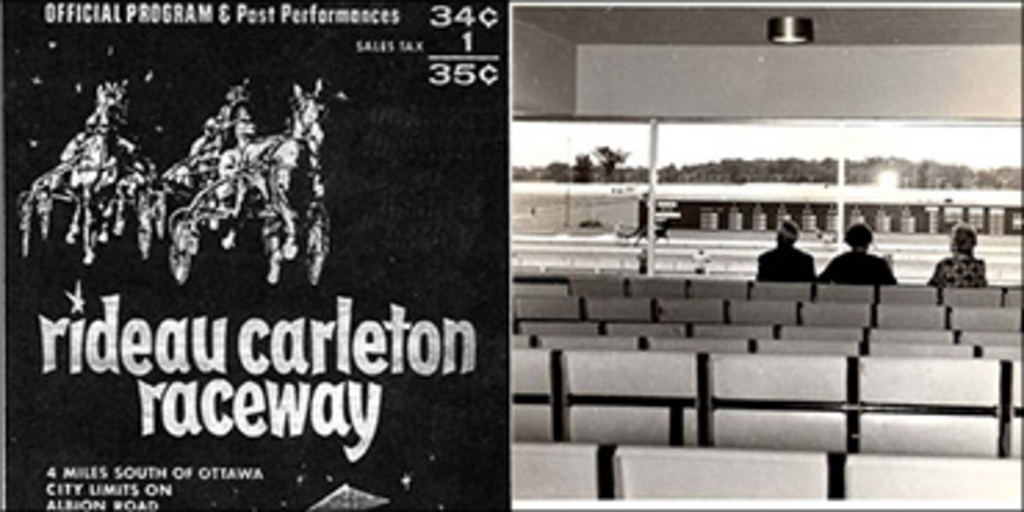
 In this week's Rewind Robert Smith remembers the opening of Rideau Carleton Raceway in 1962. This event marked the first brand new Racetrack to be built during the decade which finally saw night-time racing come to Ontario. This is the first of a two-part offering.
In this week's Rewind Robert Smith remembers the opening of Rideau Carleton Raceway in 1962. This event marked the first brand new Racetrack to be built during the decade which finally saw night-time racing come to Ontario. This is the first of a two-part offering.
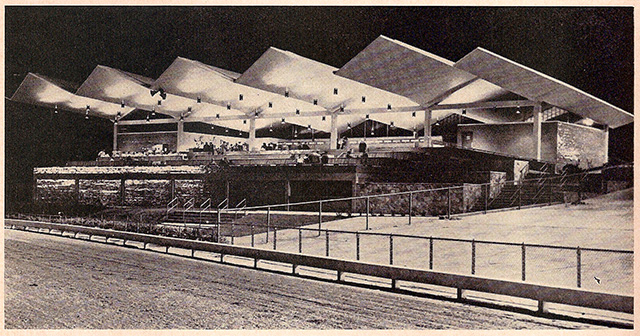
Scioto Downs served as inspiration for Rideau Carleton Raceway
The decade of the 1960's was a great time of growth and development for the sport and business of harness racing in Canada and in particular Ontario. In some ways, as much as I hate to say it, it was somewhat the exact reverse of what is happening today. Something akin to the old hymn based on the biblical inspiration from Ecclesiastes "There is a season...a time to build up; a time to tear down."
In 1962 the new and ultra modern Rideau Carleton Raceway opened its doors for their first season of operation. After a torrid and hurried building schedule and despite not being quite finished, racing began on Saturday, September 1, which of course means that nearly 54 years have now come and gone. I have been fortunate to talk to a couple of people who were there for this momentous occasion. It was an exciting, eventful and memorable time in Canadian harness racing history.
 The Rideau Carleton track and racing operation was the brainchild of a gentleman named James William Baskin. Originally from the small Ontario town of Norwood (born in 1920), he later relocated to Renfrew in the Ottawa Valley. A long time horseman who trained and often drove his own horses, he was at this time a sitting member of Parliament (PC) representing the riding of Renfrew South. A lumberman, businessman and politician throughout his lifetime, he also served four years in the R.C.A.F. during WW II. His idea was to build a Racetrack and his five-year dedication to achieving this dream resulted in the new Rideau Carleton track located in the nation's Capital.
The Rideau Carleton track and racing operation was the brainchild of a gentleman named James William Baskin. Originally from the small Ontario town of Norwood (born in 1920), he later relocated to Renfrew in the Ottawa Valley. A long time horseman who trained and often drove his own horses, he was at this time a sitting member of Parliament (PC) representing the riding of Renfrew South. A lumberman, businessman and politician throughout his lifetime, he also served four years in the R.C.A.F. during WW II. His idea was to build a Racetrack and his five-year dedication to achieving this dream resulted in the new Rideau Carleton track located in the nation's Capital.
A plot of some 300 acres was secured on the northern outskirts of Ottawa in the Gloucester Township area on Albion Road in an area locally known as Johnston's Corners. It was a spot which he knew to be "wet" as the saying was used to designate that alcoholic beverages could be served there. Through his political connections he also felt confident that modern multi-laned roads would soon be built in the area to make his new site easily accessible to racing fans. It was also just about two miles past the new Uplands Terminal, thus facilitating air travel. It was estimated that at minimum, one million potential fans were within an easy drive of the new facility. If the venture were to fail, the location should not be a factor.
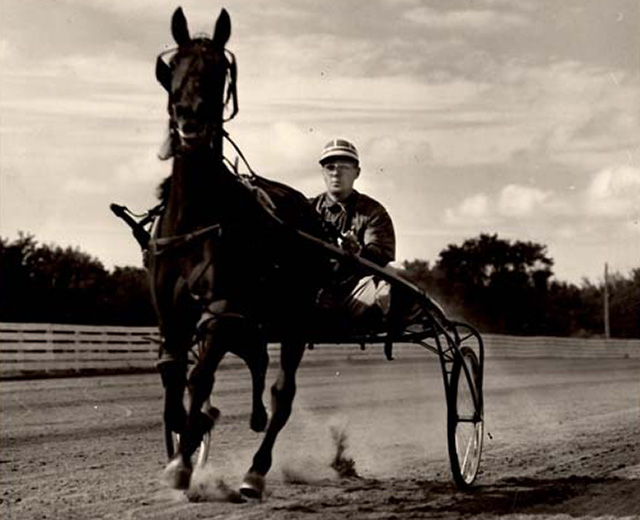
Track operator and horseman Jim Baskin circles the brand new Rideau Carleton track in Ottawa prior to the grand opening in 1962 [RCR Archives]
As part of his strategic plan, Jim Baskin assembled a group of 20 knowledgeable horsemen to serve as an advisory board for his planned enterprise. Most were Ottawa Valley residents and part of the local horseman's association. Although they were not financial partners, he sought their valuable input. (List shown below *)
While Mr. Baskin stood firm in his belief that his new track could be built in the allotted time and for the approximate budget of $2,500,000, many others in government and within racing circles harboured doubts about its feasibility. Baskin was very thorough in his plan as he secured approval from every level required including securing sufficient racing charters to conduct at least 70 days (or nights) of racing. This was crucial at that time.
His presentation to the Ontario Securities Dept. to secure financing was said to be a 'masterpiece'. It included every detail possible, even the aspect of 'breakage', a topic seldom discussed by track operators. It involves the sort of 'odd pennies' not paid back to the bettors, thus retained by the management. He theorized that based on a nightly mutuel handle of even $100,000, he could add an additional $1,500 to the Raceway's coffers.
Baskin felt that the Ottawa area was an ideal choice for a harness track location. Tales of long ago described the Ottawa Valley being a hotbed of harness racing. Early records dating back to the 1800's spoke of winter contests run on the frozen ice of the Ottawa River under the shadow of the Parliament Buildings. Another rather subtle reason may have been that the Nation's Capital, and the celebrities that frequented it, deserved better facilities and better racing than those situated a few miles away at Connaught Park just across the river.
In early August a brief ceremony was held to lay the cornerstone for the grandstand. At that time Rt. Hon. John Bracken of Manitock said he had witnessed harness racing from Vancouver Island to Prince Edward Island and added "Ottawa was a natural setting for a raceway."
The Rideau racing plant was built in an amazing seven months under the direction of architect and building director D'Arcy Helmer, a 40-year-old U of T graduate engineer who strangely had never visited a racetrack prior to accepting this huge assignment. His previous tasks had involved schools and hospitals in the Ottawa Valley, but NO racetracks. Early in the process Helmer went on a tour of several newer U.S. racetracks and formulated his "game plan". His travels were facilitated by the fact that he flew his own plane, a Piper Comanche.
He reportedly personally explored every aspect of existing tracks, often trying to place himself in many situations as a potential patron of the track he was designing. He hung around the stables, the pari-mutuel windows, and rubbed shoulders with the mink coat set in the clubhouses. He was concerned that the finish wire be located where everyone could have a good view, not just those in the clubhouse. His design took that into consideration along with numerous other 'niceties'.
Helmer filled dozens of notebooks with his findings and observations. He even thought of the horse's comfort needs and rounded all of the cement block corners in their stables. A number of local building firms were utilized in the construction phase, including the Sullivan Construction Co. from Arnprior who were awarded the contract to build the grandstand and clubhouse for a reported $841,000. The H.J. McFarland Co. of Picton handled the site work which at times involved moving 20,000 cubic yards of fill a day for the grading and shaping of the track.
Because of the demands of overseeing and trying to stay ahead of the construction crews, he apparently often worked until midnight, then headed home but was back on the job in just a few hours. He made his deadline and the track opened on schedule. When asked if he would design another track if ever asked, he said "It would be a piece of cake."
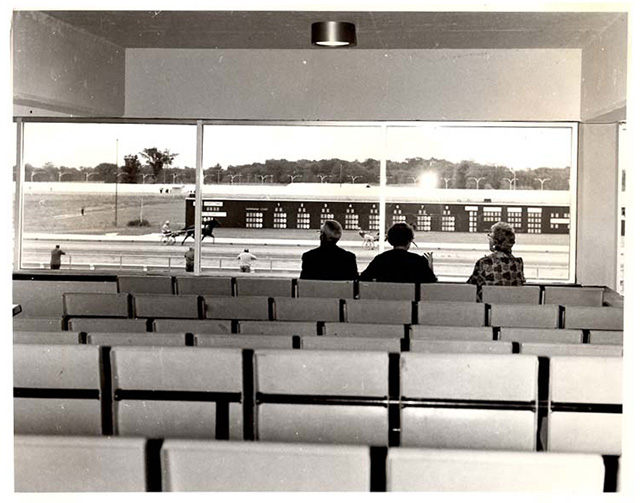
A few fans try out the view from inside the new grandstand at Rideau [Rideau archives]
The racetrack itself, which became Canada's first ever five-eighths mile oval, was constructed at a reported cost of $750,000. It was flanked by 12 fireproof stables capable of housing 500 horses. For the horsepeople, a total of 96 tack rooms and a restaurant were part of the complex. It was truly well-planned and well-built for the new age of racing and I suspect would have been the first Canadian track with a clubhouse in the original design. While he drew on ideas from a number of racing facilities, his main inspiration for the design came from Scioto Downs, located in Columbus, Ohio and built in 1959.
From a racing standpoint the purses offered were reasonable if not on the generous order based on the economic times. Included in the proposed 70 nights of racing were 14 early-closing events, two carrying top purse money of $3,500 which increased with entry fees. With a minimum purse of around $400, that would be approximately equivalent to a bit over $3,000 in today's dollars considering inflation.
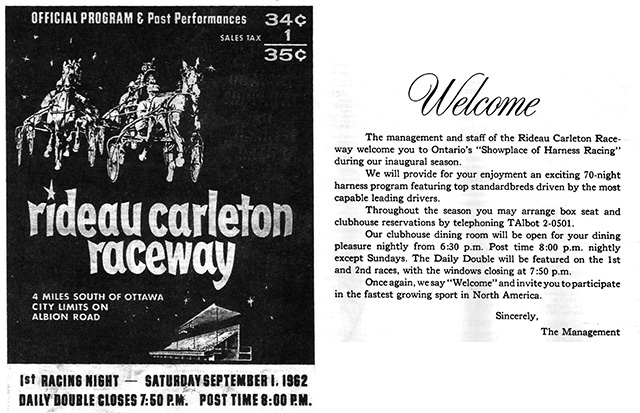
Left: Front cover of opening night program. Cost 35 cents. Right: A message from the opening night program.
On the evening of Saturday, September 1, 1962 Mr. Baskin delivered on his promise to start on time, preserving his reputation as a man who kept his word. A full card of nine races went forward as he had long predicted. Much to his delight I am sure, the show was played out in front of a full house, or perhaps more correctly a full grandstand.
Original Rideau Carleton Raceway Officers: James Baskin, Executive Director; Albert Gale, President; Harvey J. McFarland Sr., Vice Pres.; Robert E. Fasken, Sec. Treasurer; Don H. Roberts, Gen. Mgr.
* - List of Advisory Board Members - Jas. Baskin M.P., Elgin Alguire, Warren Armstrong, Donald Booth, Cecil Carleton, James Connors, Walter Denault, George Eady, Dr. John Findley, Walter Henderson, Clinton T. Hodgins, Lesley Ireland, Thos. Lennox, Parker Locke, Hudson Patterson, Chas. Philip, Robert Polk, Claire Smith, Ernest Smith, John Thompson.
A second story devoted to Rideau Carleton's opening in 1962 will appear in an upcoming Rewind.


A group of us drove up from
A group of us drove up from Belleville for opening night and as Ron Francis commented - it really was a zoo! The facility was most definitely not completed and though we got there early enough there was hardly any parking places left in the definitely unfinished mud and gravel parking lot. The crowd was so huge you could hardly move in the unfinished grandstand. In the men's washrooms there were no toilets or urinals, just the pipes in the floor where they were supposed to be placed. They had some new fangled Mutuel system where the tellers swung an arm around over the a circular thing with the numbers, types of bets etc were displayed and pressed the thing down like a Morse Code key on the requested number. Of course nobody had adequately tested this thing and when betting opened for the first race the tote board lit up like a Christmas tree and mutuel tickets started spitting out from every machine in a steady stream. After a delay they finally did get everything working and the racing started. The track itself was fabulous and the sight lines were great from anywhere and the racing was pretty good. I never got to race there but I was a quite frequent spectator until I moved away from Belleville.
Once again Mr. Smith, thank
Once again Mr. Smith, thank you for the memories and a great job.Ron
I was there for opening
I was there for opening night. My family had two or three horses racing on the card. My most vivid recollection was the strong smell of fresh concrete. It was an absolute zoo that evening.